Winter produce for the creative pantry and kitchen includes liberal and imaginative use of tubers and roots, dark sturdy greens, all of the allium (onion and garlic) family, and an array of multicolored, whimsically shaped hard-shelled winter squashes.
Cold-weather vegetables are true multitaskers, capable of nourishing and sustaining us in fragrant pots of warming soups and casseroles, or simply steamed, roasted, or baked. The brilliant colors, assertive flavors and crisp textures of winter vegetables and fruits used raw or marinated in salads and slaws are also outstanding.
There are many compelling reasons to “follow the seasons” in our kitchen as we continue to learn more about healthful and responsible eating. In this country, on average, most food has traveled some 1,500 miles to reach us, all powered by petroleum. Eating seasonally means eating more regionally grown foods as they come into season, supporting local agriculture, economies, the environment and our health. And it’s delicious too!
Let’s talk tubers
Bless all the potatoes! I love the familiar, mealy Russet Bakers (preferred for mashing), as well as the more waxy-fleshed Reds, Yellow Finns, Yukon Golds, Fingerlings and types that are red- or purple-hued outside and inside.
Sweet potatoes are in a different family. They include the dark Red Garnets and Jewels (which are called yams, but are not) and a lighter-skinned variety just called Sweet Potato. It is easiest to just bake them naked (but on a pan, since they ooze sticky sweetness).
Refrigerate extras for three or four days. They’re wonderful with mashed black beans and steamed chard, wrapped in whole-wheat tortillas. Or toss them into a blender with a pinch of pumpkin pie spice and a few drops of vanilla, and blend with or without the fully edible tender peel. Add tofu, nondairy yogurt or nondairy milk to the blender for added protein and calcium for a rich, thick or thin instant “pudding” or beverage.
Beige or purple Jerusalem Artichokes are neither artichokes nor from Jerusalem. They’re in the sunflower family. “Girasole” is Italian for “turning to the sun,” which morphed into “Jerusalem.” According to some studies, their unique starch, inulin, may possibly help improve colon function and may also help stabilize blood sugar levels. Skip peeling; just boil, steam or roast, whole or sliced, and serve whole or mashed, hot or cold — just like potatoes. Raw slices are great in salads.
Radical roots
Stand-bys are carrots and beet roots, and the indispensable garlic and onion bulbs, leeks and shallots. Now try parsnips, the cream-colored, tapered, carrot-shaped roots. Another delicious version is to mash boiled parsnip and potato together. Suggestions for seasoning would be: vegan butter, extra-virgin organic coconut oil, and a bit of sea salt. Mmmm, what a winter treat … but wait! There’s more possibilities for parsnips: scrub briskly (peel if you must) then slice into coins and sauté briefly in coconut oil. The sautéing to a golden brown magnifies the sweetness of parsnips like nothing else!
A similarly sweet and chewy texture is achieved by dicing raw parsnips, tossing with olive oil, salt and minced fresh rosemary quills, and roasting them (singly or with other roots such as turnip, carrots, rutabagas and carrots) at 375 to 400 degrees F. for 30 to 40 minutes in a single layer — stirring two or three times. The result is irresistible — hot, warm or cold tossed in a vinaigrette as a cooked salad.
Don’t overlook the all-white, crimson or purple-topped turnips, the long white Japanese Daikon radish, or the venerable softball-sized rutabaga. These are powerful elders of the family of cancer-fighting vegetables known as crucifers or brassicas (which includes all cabbage and mustard family members). All can be eaten raw (grated or sliced, in salads or slaws) or steamed, boiled or roasted. In fact, the amazing rutabaga can be boiled and mashed, seasoned like pumpkin, and makes a terrific baked pie (It sounds implausible — but it’s true!).
Horseradish roots can become your own horseradish sauce or relish. Celeriac is a celery grown mainly for its pungent root, used cooked and puréed in delicate soups, but is also delightful, grated raw with carrots and tossed with a zippy mayonnaise for a different take on slaw.
The long, brown burdock taproot (called “Gobo” by Japanese, who treasure it), is valued as a blood purifier, amongh other attributes. Scrub the root briskly, trim, peel if you insist (!), slice into rounds or grate on large holes of grater. Sauté with carrots and a few dried dry shiitake mushrooms (soaked, and be sure to use the water). Add a splash of Japanese mirin (cooking wine), water and soy sauce. Sometimes I add a bit of grated ginger. Simmer until tender, and serve with brown rice, sprinkled with toasted sesame seeds and soy sauce. Or just slice and add the burdock to any winter vegetable soup, stew or stirfry.
A field of greens
Kale varieties: A dark greenish-black, bumpy-leafed popular green that’s become very popular in recent years is Lacinato Kale, also called Dinosaur kale — or simply Dino-Kale! There’s also Red Curly kale, a larger, oak-leaf shaped Russian or Red kale, and Curly Green kale. All can be braised, steamed or boiled (for soup purées) or minced, raw, for salads and slaws. Try to use stems and all for maximum flavor, nutrients and value.
Discard any very large, older leaves, and especially, discard any yellow leaves. For raw salads, choose the smaller, younger leaves, and always cut into smaller pieces than you might if you are preparing romaine lettuce or other salad greens. Make liberal use of all of these, as well as the light green curly mustard greens, or other mustard greens.
Collards: Nestled next to the kale in the well-stocked organic produce department, you’ll find bundles of flat, medium dark greens, with long light green and quite thick stems. These are the fabled collards — a serving of which provides calcium about equal to a large glass of milk.
More cruciferous and brassica veggies: In fact, this entire family of brassicas or cruiciferous greens is high in vitamins A, C and E, plus iron and calcium. And don’t forget to try all their relatives: Napa, Red or Green cabbage, arugula, bok choy, pak choi, broccoli, broccoli rabe or brocollini, red radicchio, escarole, and cauliflower. All are super-heros, cancer-fighters, and the super-heroes of their extensive family.
Serve steamed or braised greens with a splash of red or white balsamic or apple cider vinegar and a bit of olive, sesame, hazelnut or walnut oil. Another treatment is to serve with Japanese plum (also called ume plum) brine vinegar, which sweetens these greens.
Here’s a secret: Since winter greens are grown in colder climates, the sulfur compounds common to their clan are not bitter, as happens generally when this family of greens experiences a sudden heat rash in the garden. Because these greens are grown with plenty of cool days, they should be mainstays in most regions during the winter season — and are frequently grown locally or more regionally than are the tender leaf lettuces that in such seasons, for most of us, are shipped in for hundreds or thousands of miles.
Chard: The chards are very interesting, because they are tender-leafed greens in the beet family, and yet their tender leaves are amazingly tolerant of quite cold weather. In the Puget Sound regions of Western Washington, for instance, where I live, these thrive in our gardens usually all winter long. The chards are also as brilliantly plumed as a Bird of Paradise, with long and graceful stalks, veined with bright colors attached to large, flattish and delicately culing green leaves.
The contrasting colors — some in white, crimson, orange or bright yellow — make dramatic presentations served raw in salads, or just lightly steamed or sautéed and splashed with a light vinaigrette or lemon juice and oil. Their flavor is delicate and smooth, similar to spinach, but lower in oxalic acid than spinach. Speaking of which, there are some fine old varieties of hardy winter spinach, and occasionally the winter farmers markets in our area will have them. But generally these varieties have not yet been common in produce departments.
Emperors of the garden
These are the magnificent hard-shelled squashes and pumpkins. As with potatoes, there are two basic textures found in these exceptional vegetables. The long tan variety with a bulb on the end is the Butternut and it has smooth, creamy and waxy sweet-golden flesh. A similar texture and flavor are found in the Delicata. The others mostly are richly mealy. All are good baked whole, or split and baked, or steamed, or boiled, or … well, you get the picture.
Making squash easier to cut: For those who are intimidated by attempts to whack into a large, heavy shelled squash, here’s a couple of thoughts and tips: First, ask your produce vendor to cut squash for you to your requirements — halved or quartered.
Another method is to simply bake basically any sized squash whole. Just place the squash on a pan, in a 350º F oven, and let it bake. If it is quite large it can take 90 minutes (or more!) so the first time or two you do this, be prepared to experiment. Then with oven mitts, test with light pressure until you feel the “give” that signals tenderness. You’ll get the feel after a couple of times. You can then cool until comfortable for cutting and letting steam out, after which you can easily scoop out the innards and use any way you wish. Extras can be pureed and frozen for pies or other baking.
Spaghetti squash needs a different treatment: sliced lengthwise or crosswise, baked cut-side down, or steamed. When tender, use a fork to “rake” the squash, which separates into a golden mountain of “spaghetti” — just perfect for topping with anything from a simple pat of vegan butter and salt and pepper to a typical red marinara sauce. This is a real kid-pleaser too!
Goldie Caughlan is the Nutrition Education Manager for Puget Consumers Coop Natural Marketand past member of the National Organic Standards Board.
- Visit more of VegKitchen’s Seasonal Produce Guides.
- For lots more features on healthy lifestyle, please explore VegKitchen’s Healthy Vegan Kitchen page.


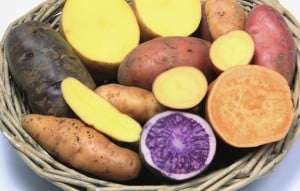
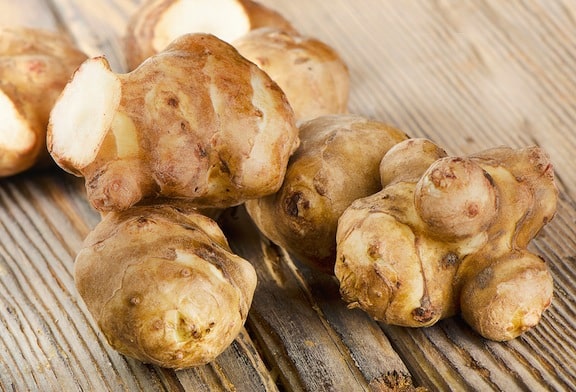
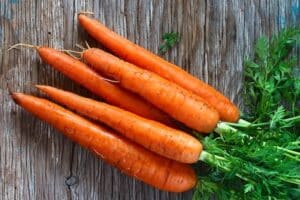
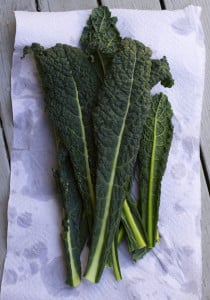

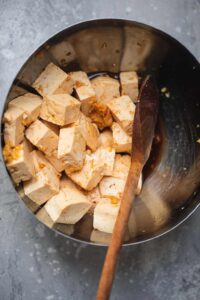

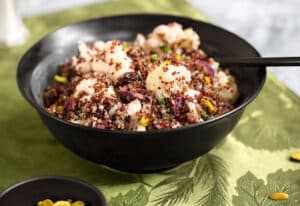

Comments
No Comments